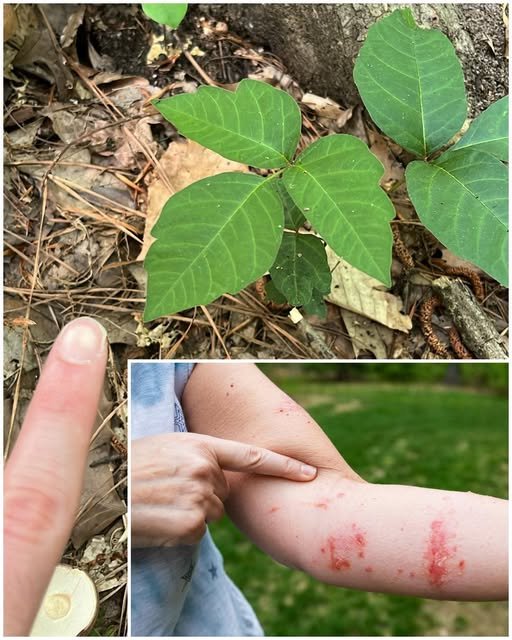You’ve probably heard the words “poison ivy” tossed around, often followed by horror stories of itching, blisters, and discomfort. But what exactly is this plant, why is it dangerous, and how can you protect yourself — especially if you’ve never encountered it before?
Let’s walk step-by-step through the essentials of Eastern Poison Ivy (Toxicodendron radicans) — the most common type in North America. Whether you’re hiking, gardening, or just enjoying the outdoors, knowing how to recognize and avoid this plant can save you from a lot of pain.
What Is Eastern Poison Ivy?
Eastern Poison Ivy is a fast-growing, hardy plant that can be found in woodlands, fields, gardens, city parks, roadsides, and even backyards. It is native to eastern North America and is responsible for the vast majority of poison ivy rashes in the United States.
It spreads both on the ground and by climbing—wrapping itself around trees, fences, or walls using small, hairy rootlets that stick to surfaces.
Why Is It Dangerous?
The danger of poison ivy comes from an oil called urushiol (pronounced you-ROO-shee-ol), which is found in all parts of the plant: leaves, stems, roots, and berries.
Even the slightest touch can transfer urushiol to your skin. For most people, this leads to an allergic reaction within 12 to 48 hours, including:
- Redness
- Itching
- Swelling
- Blisters
Some people are extremely sensitive and can get a rash even from touching clothing, pet fur, or tools that have come in contact with the plant.
Important: Burning poison ivy is very dangerous. The smoke can carry urushiol into the lungs and cause severe respiratory issues.
How to Identify It (With Just Words)
Even without pictures, you can learn to recognize it using this classic saying:
“Leaves of three, let it be.”
Here’s what to look for:
- Three leaflets per group: One larger leaf in the center, two smaller ones on the sides.
- Edges may be smooth or slightly toothed, sometimes lobed (like a mitten shape).
- The middle leaflet has a longer stalk than the two side ones.
- Color: Bright green in spring/summer, turning reddish in fall.
- Shiny or oily appearance, especially when young or freshly rained on.
- Growth style:
- As a ground cover (low bushy growth)
- As a vine climbing trees or fences (may look hairy due to rootlets)
- Sometimes growing like a small shrub in open areas
Where You’ll Commonly Find It
Eastern Poison Ivy thrives in:
- Wooded trails
- Edges of forests
- Yards and gardens, especially near fences or shady areas
- Vacant lots or disturbed land
- City parks and suburban areas, especially where birds may drop seeds
Its ability to grow just about anywhere — sun or shade — makes it very common in both rural and urban environments.
What to Do If You Touch It
If you think you’ve come into contact with poison ivy, act fast:
✅ Step 1: Wash immediately
- Use cold water and soap (preferably dish soap or a degreasing soap).
- Do not use hot water at first — it can open your pores and let urushiol in.
- Scrub under fingernails and clean any objects (tools, clothes) you touched.
✅ Step 2: Remove clothing
- Carefully take off any clothes that may be contaminated.
- Wash them separately in hot water with detergent.
✅ Step 3: Apply treatment if rash starts
- Over-the-counter remedies like:
- Hydrocortisone cream
- Calamine lotion
- Antihistamines (for itch relief)
- Cool compresses or oatmeal baths
❗ Seek medical help if:
- The rash is on your face or genitals
- You experience swelling in the eyes or throat
- You inhaled smoke from burning brush
- The rash is spreading rapidly or infected
How to Avoid It (Especially for Beginners)
Here are easy precautions you can follow:
🥾 Dress for protection
- Long pants, long sleeves, and gloves when working outside or hiking.
- High boots are helpful in wooded areas.
🧴 Barrier creams
- Some products are designed to block urushiol — apply before going out.
🐕 Wash your pets
- Dogs can carry urushiol on their fur even if they don’t get rashes.
🧹 Clean your gear
- Wash garden tools, hiking sticks, and even shoes if they’ve been outdoors.
👁️ Stay alert
- If you see a vine with hairy roots climbing a tree or fence, or clusters of three leaves, keep your distance.
Removing It from Your Yard
If you find it growing near your home:
- Never pull it with bare hands.
- Use gloves and long sleeves, and avoid breaking the plant if possible.
- Dispose of it in sealed bags — never burn it.
- Some people use herbicides, but repeated applications are often needed.
- You can also hire professionals if the infestation is large or near areas where kids and pets play.
Eastern Poison Ivy may look harmless — just another green plant in the woods or along your fence. But a few minutes of contact can lead to days or even weeks of discomfort. If you live in North America, chances are you’ll encounter it at some point.
But now that you know how to identify it, avoid it, and handle exposure, you have the tools to protect yourself and your loved ones.
Always remember:



